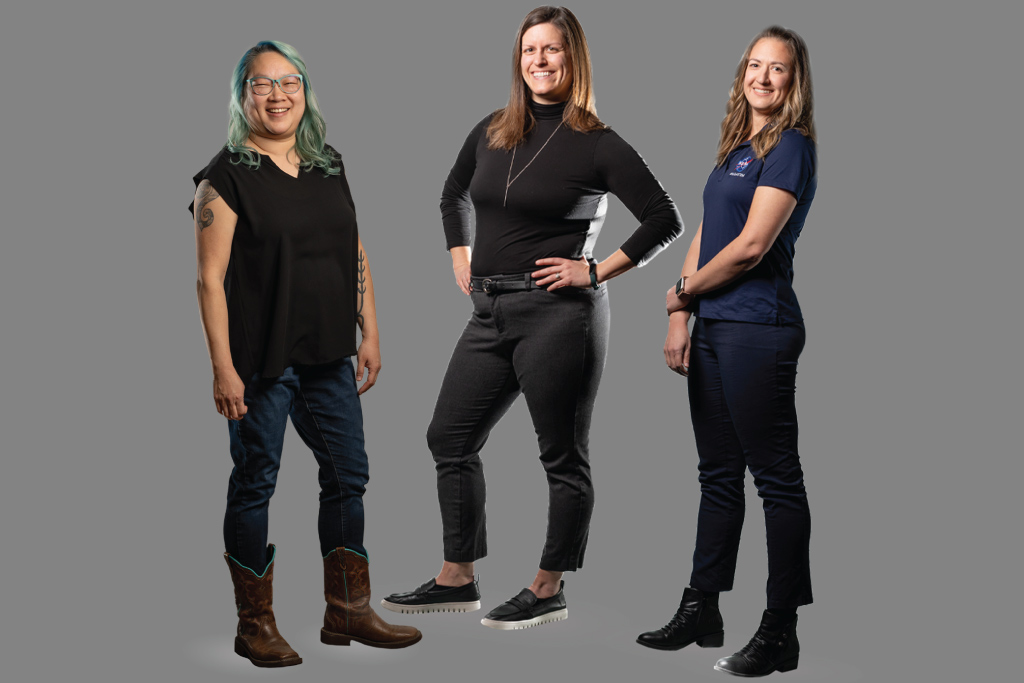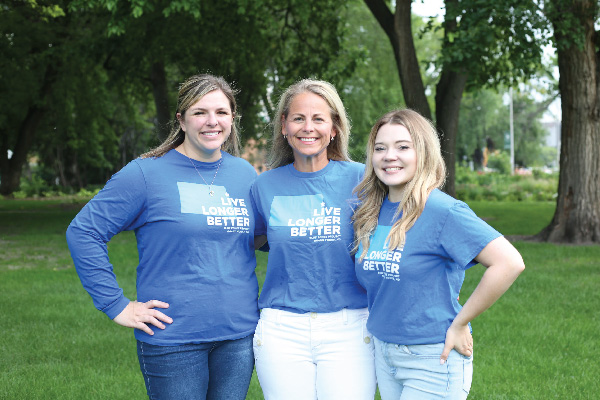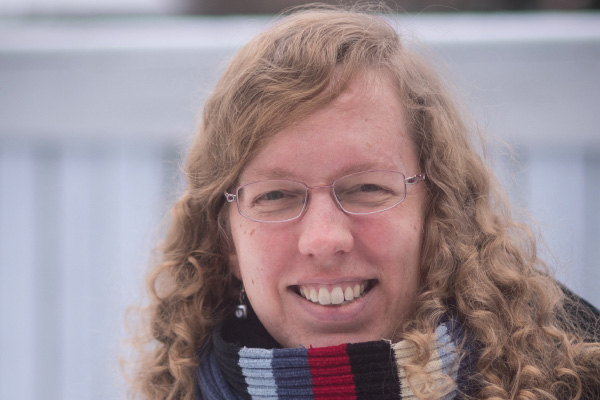Space for Everyone
Three UND alumnae open doors in STEM.
As classmates at UND, Caitlin Milera, ’12, ’22, Marissa Saad, ’14, ’22, and Kam Yee, ’15, shared a passion for space and STEM education.
Today, they’re turning that passion into action — helping the next generation of students break into the space industry.
Each woman plays a unique role within the NASA Space Grant Program, a national network dedicated to expanding STEM opportunities and ensuring students from all backgrounds see a future for themselves in science and engineering.
“We want to create an environment where everybody feels welcome to apply for our programs and feels successful in STEM,” said Caitlin, Director of North Dakota Space Grant and North Dakota NASA EPSCoR (Established Program to Stimulate Competitive Research).

(From left) Kam Yee, ’15, Marissa Saad, ’14, ’22, and Caitlin Milera, ’12, ’22, share a passion for STEM education and space.
Expanding the Universe of Opportunity
“When people think of NASA, they often picture astronauts,” said Kam, Deputy Director of the Washington NASA Space Grant Consortium and a staff member at the University of Washington. “But astronauts are just a tiny sliver of the work. Space Grant supports STEM fields that align with NASA’s mission, including aerospace, engineering, geology, and climatology. If students are interested in these fields, we can support them."
“The challenge is communicating that anyone can do it,” said Marissa, NASA-STEM Evaluation
Specialist. “You don’t need to be the smartest student in your grade. You just need
to have good teamwork and communication skills, and love what you do.”
Caitlin, an assistant professor at the John D. Odegard School of Aerospace Sciences,
emphasized that Space Grant opportunities extend beyond STEM majors. “Some of our
STEM Ambassadors are communications or psychology majors. For example, NASA has a
social media internship because they absolutely need to tell their story.”
Through the STEM Ambassador Program, college students bring NASA’s work into local classrooms, engaging young learners through hands-on activities and real-world applications.
Space Grant Challenges
The NASA Space Grant network spans all 50 states, Puerto Rico, and Washington, D.C. Kam said each state focuses on different priorities. In Washington, home to many high-tech companies, students connect with industry partners. Wisconsin hosts the First Nations Launch, a rocketry competition for Indigenous students. New Mexico offers hands-on experiences at Spaceport America.
In North Dakota, the focus is on education. “Our challenges come from being spread out, rural, and not having the resources right at your front door,” Caitlin said. Her team looks for ways to reach students at tribal and community colleges.
“Faculty at these schools are so busy with teaching that they can't take on the extra responsibilities of leading a research project,” Caitlin said. Transfer scholarships and bridge programs help students transition from two-year colleges, while NASA’s virtual internships remove barriers for those with families or transportation challenges, she said.
Marissa transitioned from her role as deputy director of North Dakota Space Grant to being a contractor for NASA’s Office of STEM Engagement (OSTEM), where she now leads national studies, develops evaluation programs, and collaborates across NASA initiatives. “It’s not enough to provide funding,” she said. “We need to know if students feel supported, if they gain confidence. The bottom line is making sure they’re not just learning but thriving.”
We want to create an environment where everybody feels welcome to apply for our programs and feels successful in STEM.Caitlin Milera’, 12, ’22 Director of ND Space Grant and ND NASA EPSCoR
A Tight-Knit Community
All three women appreciate the collaborative nature of the Space Grant program and their colleagues across the country. “It’s not competitive,” Caitlin said. “Everyone shares best practices and helps each other overcome challenges.”
Kam recalled how UND’s Space Studies program fostered that same sense of community.
“The faculty encouraged us to connect across disciplines and support each other,”
Kam said. “That’s the culture we bring to Space Grant.”
For Marissa, the program has shaped her career. “I loved being at North Dakota Space Grant and would have stayed forever. But this new role allows me to merge my passion for space with education, and that’s been incredible.”
Now, they’re paying it forward — opening doors, breaking down barriers, and ensuring every student sees a place for themselves in STEM.
NASA Terms
- EPSCoR (Established Program to Stimulate Competitive Research): A NASA program that funds STEM research in underfunded states like North Dakota, with a focus on faculty-led projects in higher education.
- STEM Ambassador Program: A NASA-supported initiative where college students lead hands-on STEM activities
in schools and communities.
Space Grant: A nationwide NASA program that supports student research, education, and outreach in STEM fields through a network of colleges and universities. - OSTEM (Office of Science, Technology, Engineering, and Mathematics): NASA’s office for STEM education, overseeing programs like Space Grant and EPSCoR to support students and educators nationwide.


